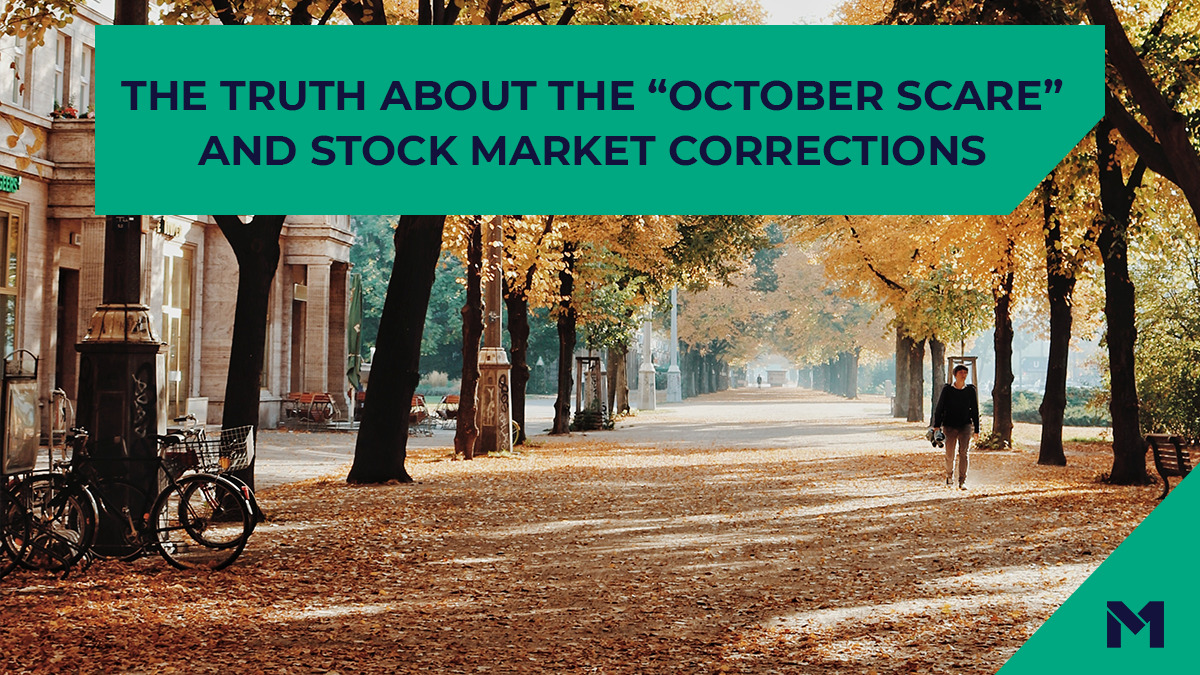The truth about the “October Scare” and stock market corrections

As the calendar turns to October, people are settling into piles of leaves, warm sweaters, and everything pumpkin spice. So why do investors historically think of this month more like a haunted house than a pumpkin patch? Why do many investors feel that something going wrong in the market is inevitable?
Historical events have shaped investors’ thinking around October, but you don’t need to be spooked this time of the year.
Origins of the “October Scare”
The October Effect explains that many investors perceive that stock markets decline during October. It’s psychological anticipation that the market will take a turn for the worse.
How did October gain this reputation? Some of the darkest days in market history took place in October and had significant consequences for many investors. These are most known as Black Monday.
Black Monday
Black Monday is a term used to describe a few catastrophic days in stock market history. It most commonly refers to the events of October 28, 1929, and October 19, 1987.
October 28, 1929
The 1929 (and original) Black Monday set the stage for the Great Depression. While it didn’t start the most famous financial crisis in American history, it played a role by destroying the public’s confidence in business investing. Between October 28 and October 29, 1929, the stock market dropped 23%.
The public realized banks were investing their money and rushed to withdrawal their entire accounts. Whether they were investors or not, many people saw their life savings disappear as banks were only able to return 10 cents on the dollar. The events are still talked about almost a century later.
October 19, 1987
Perhaps the most notorious and far more recent date, Black Monday, occurred in 1987 when we saw a market freefall after a five-year bull run. The Dow Jones Industrial Average fell by over 22%. The S&P fell by over 20%. It took around two years for the market to recover from these losses.
An SEC study found that fear over anti-takeover legislation was a catalyst for this drop. Between the three days of the bill’s introduction and its signing by President Reagan, the market fell by over 10%. This was the most significant three-day dip in more than 50 years.
These days, combined with October events during the 2008 financial crisis, solidified the idea in some investors’ minds that October is a month marred by market volatility and fear of a catastrophic event.
Calendars don’t predict market events
It’s coincidental (and somewhat ironic) that these investing superstitions coincide with the month most closely associated with superstitions. While a few doomsday scenarios have occurred in October, the month has been given an unfair reputation. Are the fears more real than fears around black cats and stepping on cracks? Sure. But investors don’t need to be full of dread every October.
Market crashes are entirely unpredictable and certainly aren’t contained to October.
The psychological effects of this are understandable, given that several of the most high-profile crashes in history have been kicked off by a day or stretch in October. However, challenging times like these are just as likely in any other part of the calendar as they are in October.
It’s especially easy to latch onto the idea that October is a bad month for investing because the days were designated “Black Monday.” Historians and the media handed out this moniker. Plenty of other disastrous financial events and market downturns weren’t given such a catchy (and menacing) title.
The most recent significant dip in the market happened in February and March of last year due to COVID-19 concerns. Spring events had substantial effects during the financial crisis of 2008-2009. The dot com bubble began to burst after peaking in March of 2001. Even with all the events in the spring over the last 12 years, we don’t think of spring as a time for a stock market panic.
The common thread between the Black Mondays of 1929 and 1987 was interest rates that were quickly climbing. Sharp rises in interest rates, and public distrust of the banks were the catalysts of these events, not that the calendar had turned to October.
Market data shows us that October has ushered in the end of bear markets more often than it has ignited a bear market. A prolonged market rally started in October of 1987 and in October of 2001 after the events of September 11.
How to avoid the “October Scare”
When it comes to anxiety around money, it isn’t all negative. Prudy Gourguechon, Senior Contributor at Forbes, explains “Mild to moderate levels of anxiety are motivating [and you can] harness that to tackle what you need to face.”
As it relates to the October Scare, use any fears as a starting point for evaluating your long-term financial plans. While short-term investors and traders worry about timing the market just right and avoiding major financial catastrophes, history favors the long-term investor.
Look at what happened after October 1929 and October 1987, keeping in mind that the market fell by more than 20%. The market has historically rebounded and looked favorably on the investor who stays focused on their habits and long-term strategy.

Here are a few ways to manage your emotions as an investor in October:
- Review your strategy and risk tolerance this month. Make sure both still line up with your long-term goals.
- Categorize media articles as potential short, medium, or long-term impact. This will bring events, and their potential impact, into perspective.
- Use October as a month to learn about a new financial topic.
- Remember the lessons that history has taught investors about October.
A balanced portfolio and discipline through times of bust and boom have proved time and again to be the habits of an intelligent investor. Rather than trying to time the market, focus on your goals and remember that patience is your friend this October.
- Categories
- Invest



